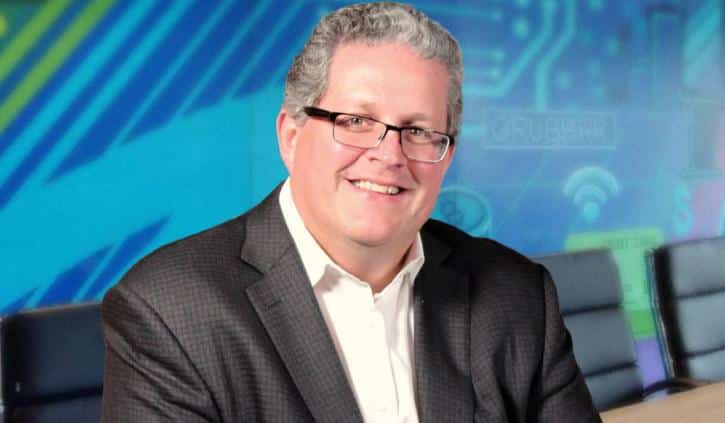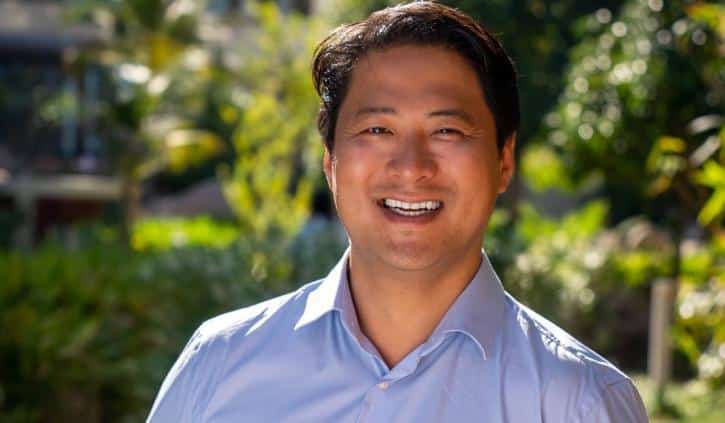





















Restaurant technology is no longer the laggard. Pandemic conditions—namely the inability to dine in—cracked wide a world of innovation that historically had trailed other industries, like retail. The reason why wasn’t a great mystery. Food is a personal experience and operators have longed relied on their gut instincts to survive. But today’s landscape, rife with technology, flooded in thanks to adoption and, also, what’s fast become an understood point—that guest experience and solutions can, in fact, live side-by-side.
As breakneck as these innovations arrived over the past couple of years, however, restaurants are now recalibrating and asking themselves what comes next. There’s no lone answer or sure-fire reality. Yet there is, without debate, a lot to discuss.
For the second year, QSR recognizes its Digital Disruptors: the change-makers and innovators laying the blueprint for a more connected restaurant world than ever.
Rom Krupp
Founder and CEO, OneDine
The year was 2018. Rom Krupp cleared the table and got dystopian for a moment. What if the restaurant industry never existed? Could a tech company approach food as an all-new sector? Krupp not only thought it was feasible, but fundamental to where consumers were taking restaurants. An industry built on guts was beginning to understand the value of data, as Krupp’s 2012-founded Marketing Vitals was proving out. But the next great disruption was unfurling within the structure of restaurants themselves. “The industry that we’re going to build will serve people food the way today food is being served,” Krupp says.
This was the starting point for OneDine, a company that’s capabilities web out into a lot of areas. At its center, though, it’s a platform that supercharges existing POS systems to enable contactless ordering and payment, to optimize labor, eliminate fraudulent chargebacks, and create a “triple-win for servers, managers, and guests alike,” the company says.
What Krupp, who has been in the business for 26 years, recognized was a lack of agility among POS devices.
As he explains it, “a ground-up rewrite of looking at the restaurant industry as a brand-new industry. Not one trying to adopt all of the things that have been adopted for the last 40 years.”
Krupp doesn’t believe restaurants need a brick-and-mortar tech stack anymore. Consider a project OneDine recently tackled. It completed a baseball stadium setup—23 concession stands, eight kiosks, 12 handhelds for VIP suites, 7,000 QR codes, and 180 pickup cubbies. But the key was OneDine did so without installing a single piece of software in the building. Everything runs from secure browsers.
“Cloud-based POS are not really cloud-based POS, they’re cloud-based databases,” Krupp says, “which means the POS is running locally but the database is running in the cloud; but there’s software running in the building. That means you have to upgrade it, version control it. We don’t. Even the software is running as a web service. So there’s nothing really deploying to the field. And that’s a brand-new way to look at the industry, which is you don’t need actual software to run the physical locations.”
OneDine early on created handheld tablets that interfaced with a merchant’s existing tech stack. It was a solution focused on labor and creating a contactless and efficient ordering and payment process for servers and diners. It established PCI and EMV compliance and eliminated fraudulent chargebacks.
However, this was just an opening shot. OneDine expanded to incorporate additional contactless payment tech, mobile menu browsing, and curbside order and payment options to help restaurants generate off-premises revenue. AI surveys, guest preference tracking, and offer management eventually made their way into OneDine’s 360-degree solution as well. It then expanded to accommodate multi-merchant venues (like malls), hotels, airports, retail establishments, and event venues, such as the stadium case.
In Krupp’s two-plus decades working with restaurants—he spent 16 years with Custom Business Solutions before Marketing Vitals—he’s seen the space evolve from POS’ infancy in 1996 to now. And what’s happened since, he says, is commerce has become increasingly decentralized. That began in the early 2000s as online ordering arrived. Krupp himself was involved in launching the integrated system for Jason’s Deli from the internet into the POS in 2000.
Restaurants quickly had different channels for online ordering and different ones for digital menus. It was an OK concept when that slice of business represented a “few percentage points here and there,” Krupp says. But in 2018, the world had morphed to 30–50 percent of sales for countless brands sector-wide.
So given how many transactions were now decentralized, the amount of effort it was taking operators to manage commerce ballooned into a massive, and often messy, undertaking.
“Because everything was still anchored in the POS systems,” Krupp says, “and the POS system was built to run the brick-and-mortar; they were never built to run kind of an Amazon concept. An ecommerce concept. Commerce is not only happening in multiple channels for you as a brand that you can control—commerce was also happening in channels you couldn’t control.”
Krupp is referencing streams like third-party marketplaces and Google ordering.
Again, going back to the ideation of OneDine, Krupp says he didn’t look at the industry’s evolution only through the lens of labor. There were a bevy of solutions working to help restaurants maintain new channels and improve flow.
Krupp says efficiencies in throttling and quoting times, and just managing kitchens in general, flashed on the horizon. “When you have multiple commerce channels, POS, on-premises, off-premises, third-party, not only do you have six or seven vendors to do commerce, but how do they know to quote the delivery driver the right timing and not effect negatively the people who showed up in the building and are sitting in the tables?” Krupp says.
And this is where OneDine staked its future: recentralize commerce and build a platform that brings all of it into a single cloud. With it, they could know what’s happening in the building, outside, in real time. Every table, guest, and third-party. In turn, restaurants won’t have to throttle in a way that had become all too common—an effort to stop people from ordering. Krupp says “throttle” remains a misused practice that can refer to slowing down the business. “For me, throttling is moving it around to optimize revenue. If you try to place an order for 12:30 and based on your mix and the time and how busy the restaurant is, I’ll tell you it’s 12:42,” he says. “You’ll probably complete the transaction and come 12 minutes later. I can squeeze that over and have that low in the kitchen where I can actually do it. We’re not throttling away business, we’re throttling it to optimize the kitchen to be busy all the time.”
Naturally, when COVID hit, these topics lit up. Brands had to rely 100 percent on off-premises. Ghost kitchens were thrown into the pool. Now, restaurants didn’t just have to throttle their own brands; they had to throttle multiple from the same station and equipment. “We had to create a system that was built for commerce and modern time,” Krupp says, “and it didn’t exist.”
“Think about how many vendors and how many partners and how many places you have menu curation and databases,” he adds. “All of that is trying to figure out in real time what’s happening. It cannot work. It just cannot. You hit the limitations of the old digital technologies of restaurants. POS as an anchor doesn’t work anymore.”
To put it plainly, the engine driving the industry was flawed. “The key here is the commerce cloud to really be the one engine to drive 100 percent of commerce,” Krupp says. “Because then all of the features up to that can work. But without that commerce cloud you can build a million features and it won’t work. That’s why you have to have 100 percent of the business transact through the commerce cloud.”
The opposite charts as follows: Use a POS to enter orders and collect payments, and nothing else. Deploy a third-party kitchen technology and third-party reporting platform. The same for labor and inventory. “But everything has to go to that engine because that’s the engine that controls the kitchen at the end of the day. And that flaw is what creates every downstream problem,” Krupp says.
On the B2C side, OneDine wanted to funnel information just as it did with systems. Generally today, because consumer data is distributed, you can have 100 customers of the same POS companies or online ordering platforms, and 100 profiles. Or 100 times a restaurant needs to set preferences and 100 different systems to conduct machine learning.
With one commerce engine, though, Krupp says, there’s a lone identity for every consumer that translates across. “Then when you go to a new restaurant that you’ve never been and you tap in with your phone or you go online to place an order, the moment you interact with anybody in the same commerce cloud, the preference engine, the recommendation engine, the filtering, is applicable to you on the first visit ever,” he says.
OneDine isn’t selling guest data, but rather using it to improve experience and offer benefits in that direction. It’s not unlike how Amazon’s recommends products across a variety of merchants.
“The advantage of a single wallet, a single address book, a single diet care preference, is tremendous to create a better experience for the guest,” Krupp says.
An example he gives is of a customer who walks into a Cheesecake Factory. What if the moment they sat down they could know what they want to eat in 30 seconds, despite the encyclopedia-thick menu? “The restaurant just gained 7, 8, 9-minute table turn times without even introducing and self-ordering or self-payment,” Krupp says. “They did it just be making it easier to decide what to eat.”
Peering into the future, Krupp says it’s going to take three to five years to unpack the innovation and adoption COVID unleashed on restaurants. “We’re still 95 percent inbound sales,” he says. “People are trying to still catch up to COVID.”
So “the next big thing” is likely further out than some think. Presently, however, Krupp believes the industry is fast-tracking toward handhelds. Accelerate those five years and he doesn’t believe there will be a restaurant in the country not taking orders tableside and accepting payment.
Afterward, turn the dial to payment. “I think that’s where the world is going to be,” he says. “Trying to find a way to eliminate credit card fraud to the point where we can drive the credit card companies to go to a sub-1 percent rate, that’s where it’s going to go.”
“The good news is this industry will never stop innovating,” Krupp adds. “I’ve built a career here. Twenty-six years. I’ll probably be doing restaurant tech until the day I die, just because, I get bored and I build new stuff all the time. That’s what I’ve done. There’s never going to be boredom in this industry.”
Stacy Peterson Androes
Chief technology officer, Wingstop (former, now CEO of Jeni’s)
Stacy Peterson Androes joined the company in 2013 when online ordering represented 5 percent of sales (she departed Wingstop in December to become CEO at Jeni’s). But for the past few years, the digital experience at Wingstop couldn’t be a bigger 180. More than 60 percent of the chain’s sales are now digital, and the long-term goal is to digitize 100 percent of transactions. The concept took a big step forward in this endeavor with the opening of a 1,300-square-foot digital-only restaurant in Dallas. The store is optimized for carryout and delivery customers; if one didn’t order ahead they can use a QR code to order inside the store.
“It’s not exactly easy to do this kind of transformation,” Androes says. “It requires a lot of foundational work. You can’t just have a digital business and have that underlying technology deprecating at the store. So there was a good solid two years of converting the system to a common point-of-sale system, making sure our menus were aligned across every single one of our stores, so that when we did layer on top these extensions to our brand like a digital business, it had the right foundation to be successful both for the operators and the guests.”
For Wingstop, Androes says the next frontier is building its digital presence internationally. The brand is repeating some of the early steps it took while reimagining the domestic business. The goal is to make the right initial decisions so the fast casual can grow the right way in terms of store count and operational capabilities, “unlike a lot of the pizza players where their growth got ahead of their technology investments,” Androes explains.
Androes also recognizes that sometimes technology can be too much. Wingstop strives to have a simple and efficient model, and its rule of thumb is that a solution can’t stand in the way or add a bunch of steps to existing operations. Even though sales are now a majority digital, it takes the same amount of time for a worker to prepare a web/app order as it would if they rang it up at the in-store POS system. Androes says there are a number of initiatives Wingstop turned down over the years because they didn’t pass a multi-step test of—can it be easily adopted into operations, is it good for franchisees, does it work well for customers, and is it worth it from a cost and complexity perspective?
Some of the things that didn’t make the cut in the past include automated pickup lockers and AI phone service technology. At the time, Wingstop chose not to pursue this infrastructure because either the technology wasn’t quite there or the cost model didn’t make sense. But, with business changing significantly in the past two years, including the labor environment, the fast casual is taking a fresh perspective at resolving phone ordering issues.
“Using machine learning and AI solutions as well as call centers, and it’s under different conditions, that technology may make sense yet again,” Andores says, projecting Wingstop’s potential future.
Meredith Sandland
CEO, Empower Delivery, and co-author of Delivering the Digital Restaurant
Sandland, who along with Carl Orsbourn, co-authored the Axiom 2022 Business Book Award Winner, “Delivering the Digital Restaurant,” came to restaurant technology through development. Her first large-scale tech project was digitizing market planning at Taco Bell, a brand she helped build 1,000-plus units for as chief development officer. “We created sales forecast models, cannibalization models, and data visualization tools using the latest data sources like mobile phone traffic,” Sandland says. “Now, these approaches are an expected part of an advanced real estate strategy. The big change? The SaaS-ification of our industry. Even a one-unit restaurant can access the tools huge chains historically spent millions building internally.”
Sandland’s next exposure came through Kitchen United, which she joined as employee No. 4 to create its business model, raise initial capital, and serve as the public face of the GV-backed disruptor. “To work, a ghost kitchen must have a top-notch digital ecosystem because, by definition, most consumers are accessing the food digitally,” she says. “What we see now is an explosion of MarTech and OpsTech. On the MarTech side, companies are creating digital relationships with the consumer—everything from the third-party marketplaces, which are really just food-specific search engines, to CDP and loyalty platforms like Bikky and Thanx. On the Opstech side, players like Galley and Restaurant365 are infusing technology into the back-of-house.”
In September, Sandland and co-founder Chris Baggott announced the launch of a new venture—Empower Delivery, which is the software that powers vertically integrated virtual restaurant and ghost kitchen ClusterTruck. As a SaaS company now available to all, Empower Delivery enables restaurants to profitably and sustainability serve the delivery occasion through a holistic architecture that uses data from each part of the process to inform decisions. It was battle-tested at ClusterTruck, delivering more than 3 million orders during the last six years. “I stepped into the CEO role because the Empower Delivery software is exactly what I have been looking for these last two years while writing the book,” Sandland says.
“Empower Delivery is software purpose-built for the delivery-optimized restaurant,” she adds. “It enables faster delivery times, higher quality food, better margins, lower prices, and less complexity.”
Broadly, Sandland believes the industry is headed for a period of consolidation after five years of breakneck innovation. Point solutions could be acquired into larger entities that offer more end-to-end technology suites for restaurants. “SaaS was exciting for smaller players because it leveled the access playing field to great technology,” she says. “But it does tend to create a lot of complexity, and independents and smaller restaurant chains don’t always have the staff to keep track of so many different pieces of tech. As more holistic suites become commonplace, the playing field will be further leveled.”
And the next big trend? Automation, but not in the sense of robots replacing humans. “As we’ve seen in cars, electrification and smart augmentation of human operators are pre-conditions to automation,” Sandland says. “I think we will see increased adoption of electric cooking equipment, smart ovens, and software that increases human productivity in the restaurant.”
Zach Goldstein
CEO and cofounder, Thanx
Zach Goldstein founded loyalty and digital engagement platform Thanx in 2011 to help brands use data to drive lifetime value. Like many elements of restaurant tech those days, the industry was lagging other fields, like retail. Goldstein felt if restaurants could catch up, they had an untapped avenue to nearly double revenue without adding a single guest. It would all come from existing users.
Thanx focuses loyalty programs on access, status, and personalization over rote discounts, and it delivers marketing automations and lifecycle campaigns (like converting a two-time customer to a third visit) to enable segmented, personalized marketing. “Since 2018, I have been writing and speaking about the massive disruption and threat restaurants face from third-party delivery,” Goldstein says. “Never has it been more important for brands to own their customer relationships directly; this starts with exceptional first-party digital experiences [online ordering] and on-brand incentives for customers to come back over-and-over again [loyalty]—these are our bread and butter at Thanx.”
Before Thanx, Goldstein, working as a consultant at Bain & Company, helped bring a private-equity owned restaurant back to life. The chain was debt saddled and new units were less successful than existing ones. Using data, he helped refine site selection, menu innovation, marketing segmentation, and executive hiring. But at the time, Goldstein says, e-commerce giants were growing larger by the day, propelled by the sophistication of their loyalty programs and the ease with which they measured and acted on customer lifetime value and customer acquisition cost. “These concepts were largely absent from restaurants and I wanted to change that,” he says.
Much has shifted since 2011. Goldstein says the world “loyalty” itself was long a pejorative for restaurants—or something only discount-oriented brands embraced.
“While brands shied away from rewards, they also continued fumbling around in the dark with marketing,” he says. “Famously, Chipotle announced they would never launch a loyalty program; theirs is now among the fastest growing in the industry, alongside previous holdouts such as McDonald’s. Loyalty has become essential because brands are competing in a digital-first arena—not just with each other, but with their third-party partners as well.”
And now, other than some fine-dining concepts, nearly every restaurant is leaning into digital and off-premises, and finding loyalty integral to all of it, especially when it comes to stripping discounts and guarding margins.
“This next era in restaurant technology will move beyond ‘does it integrate to my POS’ and toward true data interoperability and transferability,” Goldstein says.
No longer will the POS be the core of a restaurant’s tech stack, he adds. “Capturing 360-degree data about your customers and the ability to interact with them personally, regardless of channel, are becoming just as mission-critical as producing differentiated food,” he says.
Goldstein believes the next big tech trend will be automation and ease-of-use across tech platforms. “This is an area where set-it-and-forget-it — but with the help of an intelligent engine at the core—is actually possible,” he says. “We know that restaurant marketing teams are resource constrained. That is why we’ve made data-driven marketing effortless with capabilities like One-Click A/B testing and Customer Lifecycle Insights and Recommendations, both of which identify key opportunities for revenue growth and suggest automated campaigns based on real-time customer data.”
Celeste Stevens
KFC U.S. manager of digital customer experience and engagement
Celeste Stevens, KFC U.S.’s manager of digital customer experience and engagement, loves her role’s intersection between marketing and technology. She is responsible for guests’ technological journey across CRM, e-commerce, loyalty, and customer-facing digital programs inside restaurants. At its core, the job is geared toward leveraging data and segmentation in a thoughtful way to determine how, when, and where KFC engages. Steven says the most successful personalization strategies are those that anticipate the wants and needs of each consumer.
Thanks in part to her efforts, KFC U.S.’s digital sales increased 70 percent year-over-year in 2021, driven by delivery and a new e-commerce platform. In Q4 2021, the chicken giant rolled out Quick Pick-Up, a process in which customers are able to grab mobile orders off cubbies inside stores.
“KFC has made significant progress in understanding who our customers are, what they purchase, and what drives them,” Stevens says. “We’ve built a world-class marketing technology stack to analyze and measure our customer behavior and have started to put it to work to activate against our customer segments.”
Stevens began her career in digital advertising before entering the quick service space and quickly falling in love. When she started, restaurant technology was mostly focused on back-of-house systems, but recently, she’s noticed a shift to customer-facing solutions. That doesn’t mean the kitchen is taking a backseat, however. Stevens predicts the industry will see full automation in respect to food prep and order fulfillment based on real-time demand, inventory levels, and forecasts. This in turn will allow workers to focus more on the hospitality side of business.
Brendan Sweeney
CEO and cofounder, Popmenu
The idea for Popmenu wasn’t born from a complicated place. Brendan Sweeney, with a background in internet product development, user experience, and marketing, had a clear observation: marketing a restaurant with a text menu was just not the right way to put your best foot forward in a digital world rife with expectations, he says.
So Popmenu created interactive menus to serve as modern day ecommerce funnels with multiple ways for guests to engage. They feature criteria like photos, reviews, ratings, and social validation. “We treat each dish as a separate, indexed page for search engines like Google, so there is more relevant content to consider for queries such as ‘restaurants near me,’” Sweeney says. “This significantly increases traffic to the website and that traffic converts to sales at a higher rate because of the interactive elements. And because we capture guest data and preferences throughout our funnel, restaurants can automatically remarket to them with ongoing engagement plays to keep them coming back.”
Popmenu’s offering is core to its all-in-one, guest-facing platform that includes digital marketing solutions with website design/hosting and online ordering and delivery. Additionally, there’s AI phone answering with customer responses and other solutions, such as streamlining third-party delivery orders. “The platform is built specifically for restaurants. It was made to fit into their world, not the other way around,” Sweeney says.
Popmenu currently provides services to more than 10,000 restaurants. And it’s an origin story that traces back to Europe.
Sweeney was organizing an event in Paris when he noticed the restaurants they were considering all had PDF menus.
“I kept wondering why a business that is focused on taste, smell and ambiance is using text to showcase its product,” he says. “As we dove deeper and started talking to restaurant owners across the U.S., we found that there wasn’t a great guest-facing platform being offered. A lot of them were cobbling together ten different solutions, which is super inefficient, costly, and complex. They were also paying high commissions to third-party sites instead of keeping online ordering on their own website.”
Popmenu’s first-party, first-of-its-kind platform launched in December 2016. Since, Sweeney says, the company has seen more restaurants take a retail approach to marketing—a reality you can blame Amazon for. The ecommerce giant changed the game for how people make purchasing decisions. They expect photos, rich descriptions, reviews, and recommendations. “Amazon gets you to keep buying because they know everything about your searches and purchasing behavior on the site. Restaurants are bringing those same principles to the hospitality experience and it’s paying off for them,” he says.
When COVID hit, restaurant tech adoption skyrocketed. Sweeney says the industry essentially witnessed “10 years of tech adoption within 10 weeks.”
“What that ultimately did was create a willingness to think about delivering hospitality in a new way, which is especially important as restaurants continue to face a major labor gap, inflation and a potential recession,” he adds. “Agility comes from willingness.”
Much of that now revolves around understanding consumer behavior and meeting it head-on. It’s a process, Sweeney believes, that starts from an elemental level. “I’ve often said that the difference between restaurants getting by and blowing the competition away is the answer to one simple question: ‘How well do you know your customer?’” he says. “What you serve, how you serve, how you market, how you build relationships all becomes smarter and better the more you know your customer. Getting a centralized view of customer preference data is going to be even more critical going forward as restaurants compete digitally. As mentioned, guests have been trained by sites like Amazon to expect—and demand—experiences that are tailored for them. That includes when they make dining decisions.”
“It is extremely difficult to design tailored marketing outreach when your guest data is scattered across different systems that don’t talk to each other and are not intuitive,” Sweeney continues. “Building customer preference profiles requires consolidation, needs to be on autopilot and needs to be optimized all the time.”
He expects more restaurants to move away from multiple point solutions to a lone platform that captures all their guest data in one place, and then deploys AI and automation to act on that with personalized communications.
“Great hospitality is iterative,” Sweeney says. “You’re never done exploring how to make the guest experience better, and the same mentality should apply to the technology that supports you.”
Gagan Sinha
SVP, Restaurant Technology, Inspire Brands
Gagan Sinha sees the next wave of restaurant tech as an operations system that acts as a “self-driving car.”
“What I mean by that is there are so many routine aspects of our business models that no longer need to be overseen by a person, and instead can be monitored and executed with artificial intelligence,” he says. “There are many tasks that can be managed with the right technology, like creating weekly schedules for team members or overseeing food equipment. If we’re able to streamline these processes with AI, employees can shift their focus to the customers and help create a more personalized experience.”
Sinha joined the space as a software engineer in hospitality. After spending 17 years working with a variety of restaurant and retail brands, and building global teams to lead transformation and innovation, Sinha was approached by Dunkin’ to direct its next-generation technology. When Dunkin’ was acquired by Inspire Brands in 2020, his role expanded to include the full portfolio of Arby’s, Baskin-Robbins, Buffalo Wild Wings, Jimmy John’s, Rusty Taco, and Sonic Drive-In.
Sinha’s experience with Dunkin’ transcended much of what was happening industry-wide. Namely, although the sector had broadly taken a laggard approach to technology, with some prioritizing digital transformation more than others, Dunkin’ was on the forward-thinking path. “Dunkin’ had the desire to join this new wave from the start and began creating a roadmap for technology innovation,” Sinha says. “Along the way, we adjusted the underlying foundation of our brand to create a new point-of-sale, as many other companies followed suit. As restaurant technology continues to advance, I’m eager to witness how it will lead to more growth not just for Dunkin’, but for the industry as a whole.”
Returning to the future, Sinha says Inspire Brands continues to ask itself two questions: What can we do to simplify repetitive actions to focus on the big picture? And, how can the multi-brand platform use technology and progress to provide a better experience? “At Dunkin’, we’re thinking through new ways to address these questions, particularly with our drive-thru. We want to cultivate VIP experiences that recognize our guests’ commitment to the brand, including the generation of more personalized digital menu boards that present relevant suggestions based on previous order history,” he says.
Sinha adds Inspire Brands is “extremely interested” in the power of AI. Dunkin’ is fleshing out ways of using the tech specifically to automate daily operations and individualize guest services and interactions. “We want to create a space where our team members can place a larger focus on our guests, and we recognize the role that advanced tech will play in doing so,” he explains. “We recognize with our ability to leverage back of house software to further develop as a brand, and we plan on doing exactly that.”
Elevating its drive-thru is another focus. Dunkin’s sales run predominantly through the channel and the industry, in general, saw the category burst forward through COVID; not just in usage, but also in how tech could elevate the bar.
“This includes modernizing digital menuboards that highlight relevant menu items depending on time of day, adding more efficient dual-lane locations and implementing loyalty member-only lanes,” Sinha says. “We’ve also continued to evolve our loyalty app, update and enhance and update our infrastructure to enable curbside pickup options, and strengthened integration with our delivery partners. “
“With Inspire’s shared services model, we can advance our technology even further, leaving more room even more advanced innovations.”
Krystle Mobayeni
Cofounder, BentoBox, and head of Restaurant Solutions at Fiserv
Krystle Mobayeni was a web designer and consultant when she started taking on restaurant clients. One thing she couldn’t find, though, was a resource focused on the specific tools operators needed to drive revenue, things like catering orders, selling tickets for private events, and managing a concept’s presence on Google and Facebook. What Mobayeni also recognized was existing technology was driving a wedge between restaurants and guests.
In 2013, she cofounded BentoBox with Pierre Drescher to empower modern restaurants to build their online presence, diversify revenue, engage with diners, and increase operational efficiency.
Today, Mobayeni leads the restaurant solutions team at Fiserv, a global payments provider that acquired BentoBox in November 2021. Restaurant Solutions, which includes the BentoBox and Clover brands, delivers a best-in-class option and enhanced experience to restaurants, she says.
“A few years ago, restaurants and technology co-existed. Restaurants knew that they needed technology to support their business, but they looked at the on-premise and off-premise as two different experiences.” Mobayeni says. “Additionally, the restaurant landscape was built on layers of fragmented technology. Today, we see technology in restaurants shifting to a unified, modern experience that connects the on-premise and off-premise, and eliminates friction among the different technologies.”
The coming evolution, she feels, will center on an opportunity that doesn’t get the spotlight it warrants. “We hear a lot about diner data, but the real power, which gets little attention, is how technology can help restaurants make better decisions and deliver great service with this data. Knowing consumer preferences is important—what we should really be talking about is how to apply that information so restaurants can focus on the diner experience,” Mobayeni says.
The task rings familiar. Mobayeni is working to solve the fragmentation that exists in restaurant technology. To do so, her company is strengthening its omnichannel platform to deliver a blended on-premises and off-premises restaurant and diner experience. “One specific area of focus is first-party reservations,” she says. “We are working to combine reservations, POS, and websites to create a powerful offering that empowers restaurants to engage directly with their diners rather than through a third-party service.”
Karl Goodhew
Chief technology officer, BurgerFi
Karl Goodhew is relatively new to the restaurant industry. In fact, BurgerFi is his first executive position in the food and beverage segment, after past stops at Macy’s, Omni Hotels & Resorts, and JCPenney. Yet he’s leading a fast casual that always seems to be on the forefront of innovation. As chief technology officer, he’s responsible for all aspects of the customer and employee experience that includes a technological component, in addition to corporate cyber security, internal systems, data, and IT operations. The most public-facing initiative is arguably BurgerFi’s implementation of digital ordering kiosks throughout its company footprint. A pilot resulted in increased sales, 18.5 percent average check growth, and absorption of 133 orders per day on average. Franchisees, which make up about 80 percent of the system, are beginning to pick up the technology, as well. Goodhew also noted the chain’s partnership with Gopuff, a delivery platform that will introduce the fast casual to new markets across the country. The brand will be available at more than 30 Gopuff Fresh Food Halls, which is equivalent to adding five to 10 franchise restaurants in terms of revenue and EBITDA.
Additionally, BurgerFi is working through a revamped loyalty program and more behind-the-scenes innovation around a new network stack, security, enterprise resource planning, inventory, and a human resources information system. As for what Goodhew thinks the future of restaurant technology will be, dynamic pricing appears to be on the horizon.
“The restaurant industry is a lot like retail in that there are fixed costs that must be endured no matter if you have customers or not,” Goodhew says. “It’s also a lot like hotels and flights in that there is a limited number of dining slots available for a given period. There may be incentive to eat a little bit earlier or a bit later to ease that rush. There may be incentives placed to order in a typical lull to drive demand. Dynamic pricing is not something the customer is used to in a restaurant so careful testing is needed to ensure there’s little downside.”
Tony Smith
Cofounder and CEO, Restaurant365
Tony Smith loves to solve problems and has done so for many businesses throughout his career using software. This interest drew he and his cofounders to a largely underserved and fragmented market—the restaurant industry. When his group learned of the difficulties faced by operators and the complexities of different software solutions only meeting partial needs, they sought to create a unified answer. That was the genesis of Restaurant365, an all-in-one cloud-based accounting, inventory, scheduling, payroll, and HR solution developed specifically for restaurants. Customers run the gamut—major franchise brands, enterprise restaurant groups, multi-location groups, small businesses, and accounting firms in the industry.
“Over the years, the industry’s pain points continue to change based on market conditions and outside factors,” Smith says. “While I loathe to hear about operators facing difficulties, that always provides us an opportunity to continually evolve our solution and solve more problems for this industry I’ve grown a deep love for.”
Restaurant365 invests heavily into research and development to continually release new innovations. These efforts are informed by customers’ needs and the industry’s overall evolution. Human resources management appears to be the most common pain point, which is why the company is working toward expanding its payroll solution, driving food cost improvement, and providing better communication between workers and managers. This includes a new Mobile Manager Logbook, which allows managers to keep a digital record of customer concerns, personnel issues, vendor mishaps, and other impactful events. The organization helps operators identify trends and use the insights to improve business.
Claiborne Irby
SVP of Customer Engagement and Strategy, Focus Brands
In Claiborne Irby’s role, he is responsible for all customer, commercial, and strategy teams, with an emphasis on using customer insights and data to drive performance of loyalty and digital channels. Focus Brands aims to understand guests better so it can serve up experiences worth repeating. Over the past few years, the restaurant group—comprising McAlister’s, Schlotzksy’s, Moe’s, Jamba, Auntie Anne’s, Carvel, and Cinnabon—has doubled down on its customer-centric approach. For instance, the company created a full machine learning engine that automates better offers to members of McAlister’s rewards program. The engine learns from each successive run and automatically improves offers in the next go-around. It’s an improvement upon wide-casting generic offers that are often more expensive and less effective. A customer who buys just one entrée may not want a BOGO deal, but they may go for additional loyalty points. Focus Brands is now scaling this success to other brands in the portfolio.
“We are sitting on a treasure trove of data and have worked quickly to use the information we already have to make critical advancements in how we engage with our customers,” Irby says. “We are using years of historical data to build an impressive offer engine and suggestive selling capability. By leveraging existing data, we are building the right infrastructure and tools designed to delight customers and drive returns for our brands and franchisees.”
In the future, Irby believes the biggest opportunity for Focus Brands—and the restaurant industry overall—is determining what portion of technology should be owned and managed internally versus outsourced. Bringing in the right tools and resources in-house will lead to significant competitive advantages, the digital executive says.
Sterling Douglass
Cofounder, CEO, Chowly
Sterling Douglass began his career as an actuary. Or as he puts it, one of “nerdiest jobs” you can have. The combination of statistics and finance, rooted in data, provided him a foundation. But after two years, he noticed every project started with the same six-word question: “What did we do last time?” Eventually, he tackled a fresh task that left him realizing entrepreneurship might be in his path. He turned to building a mobile ordering app for bars and taverns. It allowed customers to have drinks brought to their table or be available for express pickup at the bar; no more waiting to close your tab or flagging down a server.
Douglass ran into a problem, however. Bars wanted the platform to integrated with their POS instead of getting a separate tablet to receive orders on. So he created one of the first POS integrations back in 2015. It made him face another point, though: If you could integrate orders into the POS, why not just do it for Grubub? Fellow restaurateurs in Chicago said the same thing.
And Chowly was born. The POS integration company enables restaurants to expand and maintain a diverse set of off-premises capabilities. It integrates online ordering solutions, such as third-party marketplaces, which include Grubhub, Uber Eats, DoorDash, and Postmates; third-party menu management using POS sync technology; and direct order with Google, an integration for orders placed on Google Search, Google Assistant, or Google Maps—directly into a restaurants’ POS system. The company has expanded to offer tools needed to launch virtual restaurants as well.
Douglass founded Chowly with Justin McNally. After the duo integrated their second order at local Chicago pizzeria, D’Agostinos, another light bulb clicked. There was an industry challenge at hand when it came to moving data between systems. In 2016, one of Chowly’s first restaurant partners was part of the inaugural U.S. launch of Uber Eats. The Chowly integration was live the same day.
Then came Eat24, DoorDash, and other marketplaces. Customers turned in requests for call center order integrations. Voice automation, which Chowly has had live since 2018, was added as an integration partner. Customers said they needed to sync their menus directly from their POS. Chowly claims to be the first company to release that in 2020.
Next, they wanted reporting. After, customers asked for a Google integration, and Chowly did so for SMB customers in 2021.
“If you look at Chowly’s value from first principles, it is helping to standardize and move data between systems so restaurants can implement new technology easier,” Douglass says. “While most of how Chowly does that today is with third-party marketplaces and other omnichannel marketing sources, customers are telling us they need more. Chowly is working on more advancements that will enable data to be democratized for restaurants. Next year, expect a big leap forward for the restaurant space powered by Chowly.”
Over the past six years, Chowly has added more than 12,000 restaurants to its platform and supports north of 300 online ordering integrations and 50 point-of-sale integrations.
“Everyone is talking about virtual restaurants and omnichannel ordering, and they should,” Douglass says of the current and future tech field. “It’s big, and every restaurant should be looking at it. However, underneath the hood, there’s a deeper issue going on at restaurants, and it’s not robots or drones—it’s boring old data. I believe the innovation here will be the next stage of reinforcements restaurants will receive to improve their businesses.”
Hope Neiman
CMO, Tillster
Before Hope Neiman joined Tillster, a company that provides quick-serves with digital tools like mobile and online ordering, kiosk ordering, coupon and loyalty programs, delivery in-restaurant solutions, and messaging, she worked in ecommerce for large companies and digital-only brands. She saw how much opportunity there was in the restaurant industry for the introduction of more solutions, though many were hesitant to implement technology into their businesses. Now, restaurants have had to embrace innovation in order to keep up with the consumer and their competition.
“I could see how ripe the restaurant space was for a digital transformation and I really wanted to be part of it, as my career has been built on using technology to change consumer behavior,” Neiman says.
Neiman adds one technology innovation people need to talk about more is better integration across tool sets.
“On the consumer side, this means starting with a customer data platform across all components,” she says. “But there is a lot of integrated back office technology that is easy to use, integrate, and requires limited skill sets that are really the next frontier.”
Tillster is currently focused on machine learning and AI tools, Neiman says. As a leader in in-restaurant kiosks, it uses those abilities to improve the speed of service and convenience for guests.
Aman Narang
Cofounder and president, Toast
You could say restaurants found Aman Narang—it wasn’t the other way around. Along with Steve Fredette and Jonathan Grimm, the trio often parked at a local eatery after work to sort through potential ideas. Soon, they had their “aha moment.”
“We realized there was a huge opportunity right in front of our eyes to help restaurants,” Narang says.
Then they founded Toast, the idea of an integrated experience was nowhere near where it is today. In the last decade, operators have seen point solutions expand, integrations abound, and the idea of an end-to-end solution as a possibility crystalize into view. Toast’s North Star has continued to target the latter, which is to create an all-in-one platform that enables restaurants of all sizes to run. “Combined with our partner ecosystem, we continue to innovate to help our customers stay focused on delivering hospitality—not trying to be CTO,” Narang says.
Where Toast—and the industry—goes from here, he adds, is to talk more about how tech is helping power personalization. “Which at restaurants can actually mean a better hospitality experience,” Narang says. “Some guests experience hospitality as engaging directly with a server who might be holding a handheld device, for example, while for another guest the desired experience is about an entirely digital, contactless interaction.”
“It’s incredible to think about the possibilities with personalization,” he continues. “Imagine a world where you walk into a restaurant and the staff greets you by name, knows your food preferences and what you’d like to see on a menu-–including elements such as allergy modifications—and you simply walk out of the restaurant when you’re done because the restaurant has your preferred payment method. Toast helps enable all of this to be a reality.”
Narang believes the relationship between restaurants and employees is as crucial as it’s ever been. “Through our ability to connect restaurants and these stakeholders in ways that enhance the experience for each group, we benefit the entire restaurant community,” he says.
Sam Zietz
CEO, GRUBBRR
Sam Zietz helms GRUBBRR, a self-ordering technologies company focused on automating commerce, which includes kiosks, smart lockers, kitchen display systems, order progress boards, digital menu signage, mobile ordering, online ordering, and more. Zietz also leads TouchSuite, a payment processing company he founded nearly 20 years ago. His work with TouchSuite certainly had connections to the restaurant industry with its involvement in credit card processing, commerce solutions, and POS. He noticed the shift toward mobile and kiosk ordering and, four years ago, looked into getting into the sector because of it.
He met GRUBBRR founder Bhavin Asher, who also saw this shift in ordering technology, and became CEO and majority owner of the company. Zietz focused on developing the company and its products as well as making strategic partnerships, including a partnership with Samsung.
COVID-19 popularized self-ordering technology much quicker than Zietz once thought feasible, bringing GRUBBRR’s suite of options to the forefront of the industry’s response.
Zietz says the next battleground will be customer personalization, AI forecasting, using automation to integrate front and back-of-house operations, and gathering and reporting data in real time.
GRUBBRR is working on conversational AI-based voice ordering for different channels. It is using a machine learning process called deep learning that uses a structure resembling the human brain to process data.
“One of the biggest issues with AI ordering is that it lacks a human touch: it cannot always accurately pick up on the idiosyncrasies contained in regular human speech,” Zietz says. “This is the next iteration of AI ordering software.”
Jessica Valenzuela
CEO/cofounder, GoGoGuest
GoGoGuest is a restaurant guest engagement platform that leans on customer analytics and AI. It first launched guest WiFi marketing in 2016 and has since evolved to help restaurants have access to data and to give them insights into the right marketing and operations steps.
Valenzuela has a long history of working in the space. She clocked time in a restaurant during college and grew up around the eatery her mom co-owned and managed. After college, Valenzuela held in-person and digital product marketing roles, helping activate and launch consumer brands in local and international products.
She started GoGoGuest as a way to help coffee shops get more value from customers using their WiFi without buying much product. Then, the company pivoted to focus on a guest engagement platform for restaurants.
“As buying habits shifted dramatically into the online space during the pandemic, we began helping restaurants leverage their already rich tech stacks into actionable insights for marketing and operations,” Valenzuela says.
Customer value management, or CVM, is something businesses are starting to pay attention to, she says. Valenzuela notes CVM is “the process of aligning the product with sales, marketing and ongoing success with the customer to expand revenue.”
GoGoGuest is tapping into using CVM to help customers. This means building a restaurant guest engagement platform that uses analytics and works with cloud POS, omnichannel payment platforms, reservation systems, and customer feedback platforms.
“We make it easy for restauranteurs to differentiate the value of their brand with the right data, customer analytics and insights without the need for a data engineer, data analyst or a costly technology custom development project,” Valenzuela says.
Mary Melvin
Director of restaurant technology, Checkers and Rally’s
Mary Melvin has been with the classic chain for three years, and was initially brought on to help with the development of its new restaurants’ IT initiatives. That involved bringing together all of Checkers and Rally’s partners to coordinate the installation of new systems.
Melvin began her restaurant career as a cashier at Olive Garden. During that time, the company switched out its POS, and Melvin excelled at using it. Olive Garden then recruited her to work on the help desk for the new system, and she has stayed in the field since.
“I got my foot in the door and I never looked back,” Melvin says.
Checkers and Rally’s has been implementing AI-powered drive-thrus with voice ordering since August 2021. The AI recognizes when a car pulls up to order their food and takes the car’s order, leaving the cashier to bag food and hand it off once a guest reaches the window. This takes a lot of the stress off the employee, Melvin says.
The initial pilot last August included 10 restaurants, but the company has since expanded that to 75 as of mid-August. This leaves Checkers and Rally’s with 150 corporate restaurants to bring the technology to, though some franchisees are also getting in the mix.
Melvin says that along with easing the burden of cashiers, AI-voice ordering is improving speed of service. There’s no wait time when the guest pulls up to order and the AI knows every ingredient and menu item.
“It’s great because the responses are immediate and it can answer questions and free up that cashier’s time,” Melvin says. We are seeing some really good changes in our speed of service at the menu board, so that’s really exciting.”
While the company has been successful using this AI technology in a customer-facing way via the drive-thru, Melvin says the future may be in using that same kind of innovation in the back-of-house to help employees manage things like adding items to orders or checking the temperature of the freezer.
For now, the brand is looking toward taking its restaurant of the future model up a notch. This could unfold as technology to be able to recognize certain cars when they come through the drive-thru in order to be able to remember their order and identify if they are a loyalty member. This vision of a technology-centered restaurant also includes digital menuboards where customers can see their orders in front of them.
“Right now, what we’re doing is taking a look at the architecture that needs to be in place to support some of these innovations,” Melvin says.
Zhong Xu
CEO and cofounder, Deliverect
Zhong Xu began his career in software engineering and eventually combined this experience with his passion for the restaurant industry. The latter came from his father, who migrated from China to Europe in the 1980s and worked in restaurants to make money. Xu’s father was also an engineer and learned the difficulties restaurants had firsthand. He started a POS for Asian restaurants in Belgium that he still runs today.
“My father’s trajectory and ethos not only inspired me to work in the hospitality industry, but gave me an understanding of the importance of the ‘why’ behind building a business,” Xu says.
Xu’s Deliverect is a software company that helps simplify the management of online food delivery. It combines online orders from different delivery providers in order to allow restaurants to improve services and customer satisfaction.
Automation and AI technology to help improve day-to-day operations is the future of the business, Xu says. He also notes that using smart technology like robots and drones for the distribution of food from warehouses and virtual kitchens is also becoming more popular.
“In 2023 and beyond, we’ll see continued momentum for this smart device explosion, including increasing use of intelligent delivery robots and drones,” Xu says. “Additionally, we expect ghost kitchens to continue in popularity as the industry continues to seek efficiencies and grapple with staffing shortages.”
Denny Marie Post
Co-president, Nextbite
Post brought starpower to Nextbite when she joined the company as co-president in May. The former Red Robin CEO, who also held leadership roles at Starbucks, KFC, and Burger King in her career, had served as an adviser to Nextbite since September 2021. She had a front-row seat to a burgeoning movement that’s begun to settle into something lasting. Nextbite helps operators enter the virtual restaurant space with its delivery-only menus. Post oversees marketing, operations, and culinary innovation along with providing a strategic focus with Nextbite’s restaurant fulfillment partners. “I chose to join Nextbite because I see a tremendous opportunity to re-imagine the future of the restaurant industry to derive maximum return from existing brick-and-mortar assets,” she says. “There is so much upside potential to be realized.”
Post has been in the industry since joining KFC in 1995. Back then, in-restaurant technology consisted of POS systems and the most innovative thing was a digital menuboard. Off-premises? Call-ahead takeout was about as far as that went.
“So much has happened in the intervening three decades and much more rapidly in the last 5–7 years,” Post says. “Consumer adoption of digital tools in restaurant and at home, driven in part by the contactless pandemic demand, has picked up tremendous momentum and has highlighted multiple gaps in restaurants’ ability to fulfill.”
Alex Canter, Nextbite’s CEO, directed Ordermark (which would change its name to Nextbite in November 2021) to address the challenges of managing orders from multiple delivery services for independent restaurants—like his family’s famed Canter’s Deli—that lacked the ability to integrate into POS.
“The biggest changes? Consumer digital adoption, operator engagement, and true and evident ROI for investment in technology,” Post says what’s taken place across the pandemic. “We just completed 45 hours of in-home ethnographic interviews on food delivery. The in-home business has an unlimited future with consumer expectations for seamless and informative digital engagement growing daily. We must continue to set the bar for UX higher and higher.”
Going forward, Post expects the industry to see an increased interest in harnessing data gathered from customers to create a better experience, including higher guest return rates and satisfaction. “This needs to be truly dynamic, daily input to maximize the opportunity,” Post says. “Monthly look-back reporting is no longer sufficient.”
“There are several tech advancements we are working on to help restaurants thrive,” she continues. “Data today is more important than ever, and for those restaurants offering one or more of our virtual restaurant brands, we are helping them use data analytics to be more profitable and successful. We provide self-serve access to dynamic dashboards. Another growing need is for a tech solution to help restaurants reconcile transactions and payment from third-party delivery services. We are piloting a revenue reconciliation tool to address the significant resource drain and error potential restaurants experience sourcing reports across multiple systems and providers. With our solution, restaurants have full visibility into their off-premises revenue, eliminating the possibility of manual error and delivering a high degree of accuracy for grouping and reconciling large volumes of transactions.”
Markus Sturm
SVP, digital, Tim Hortons
Tim Hortons’ market share positioning in Canada is enviable, to put it lightly. The brand sells seven out of every 10 coffees. That makes its digital footprint and ability to engage with one of the industry’s most fervent fanbases a job that’s also difficult to rival. “I consider myself incredibly lucky; I have one of the best jobs in Canada,” Markus Sturm says.
The brand’s digital leader has spent eight years in the sector. Tech adoption, both by consumers and operators, has rocketed through that stretch. On the former, Sturm says, smartphone adoption stirred a proliferation of restaurant apps. And in turn, how brands position them. “Initially, most restaurant apps were focused on functional benefits such as line-skipping via mobile ordering or earning and redeeming loyalty points or digital coupons,” he says. “But those functional features have now become table stakes, and restaurants are competing for a deeper, more emotional digital relationship with their guests.”
From the operations side, it’s been a race to provide experience for customers and workers alike. Newer service models, such as drive-thru, mobile ordering, and delivery, were all heightened throughout COVID. Meanwhile, the labor market tightened and restaurant complexities increases to meet guests’ growing tastes.
“We believe the pace of change will only accelerate, which is why Tim Hortons is highly focused on building, testing, and adopting digital technologies—both consumer-facing and at the restaurant level,” Sturm says. “At Tims, we and our franchise restaurant owners are embracing a bold digital mindset across every department and in practicality, everything we do. This includes, among countless other examples, an even greater focus on: advertising on digital/social media in our marketing department, testing new back-of-house technologies to improve operations, and designing and evolving our restaurants in ways that encourage digital guest adoption.”
In particular, Sturm is interested in the notion many retail consumer companies today derive a portion of revenues from “non-core” digital services. These have become easier and more cost efficient for consumer brands to integrate into their digital ecosystems. In large part, it’s a trend that owes to cloud technologies and “infrastructure as service” providers. Think Uber. It started as a ride-hailing or delivery company and has expanded to offer other digital services within its ecosystem. “Those additional services now represent an impressive portion of their businesses,” Sturm says. “And for good reason: they have large and highly-engaged captive audiences including customers, drivers, and merchants, and they can tailor their digital products to seamlessly integrate into their ‘core’ business models. I believe large consumer brands might increasingly extend their digital guest relationships and app ecosystems to offer additive products and services to power their core business.”
Digital currently represents roughly a third of overall sales at Tim Hortons in Canada. The chain boasts the largest monthly active app user base (it also has the highest app usage frequency) within the F&B industry in the country—even higher than third-party delivery aggregators. For perspective, about 11 percent of the entire Canadian population uses the Tim Hortons app at least once per month. Sturm says, in part, the success is a reflection of engaging experiences the brand added over the past two years, like fully digitizing its Roll Up To Win campaign and launching the Tim Hortons NHL Hockey Challenge. Additionally, it integrated community-oriented features in its loyalty offering, like “Round Up,” which allows users to instantly benefit the Tim Hortons Foundation Camps. A more recent example is “Scan & Pay,” where guests can earn/redeem rewards points in a single scan. “This will help save time at the counter or drive-thru window because guests can scan for Tims Rewards and provide payment in one simple step,” Sturm says. “This is a massively impactful feature; we anticipate it will cut current loyalty payment times in half. With roughly a third of our transactions occurring on our loyalty program, those time savings add up substantially. Our reliability and speed improvement projects such as Scan & Pay not only enhance the guest experience, they also drive simplification for restaurant team members and higher sales.”
Angela Diffly
Cofounder, Restaurant Technology Network
The Restaurant Technology Network came to life in July 2018. Diffly created the membership community to bring together tech executives, from operators to suppliers, academics, and consultants, to foster innovation. Members collaborate via working groups to create and disseminate technical guidance, best practices, and industry standards, and RTN also hosts various networking events throughout the year, including Town Hall and partner-focused events. Perhaps most notably, RTN nurtures new restaurant tech talent via Start-Up Alley, held annually at MURTEC.
“As co-founder of RTN, I steer the membership community’s overall direction, keep my finger on the pulse of restaurant tech trends, utilize my platform to spotlight innovative voices, and connect people who need connecting,” she says.
Before RTN, Diffly was closely tied to tech in editorial and corporate communications roles, as well as a “few sideline entrepreneurial adventures.” And like all of the disruptors on this list, her years of experience and know-how rocketed to the surface when the pandemic hit. Diffly says COVID changed the definition of what a restaurant is, and operators had to respond. “We have cloud kitchens, ghost kitchens, dark kitchens, automats, virtual brands, and celebrity brands, AI/ML in every facet of the operation, native/delivery-as-a-service, third-party, drone, robotic delivery, marketplace mayhem, kitchen robotics, robot hosts, servers, and so much more,” she says. “The real question is what hasn’t changed? The one consistent driver is technology. And I believe restaurants are waking up to what’s possible with technology in the driver’s seat.”
It’s a future rife with possibilities, Diffly adds. New generations are often more comfortable with tech than people. “And they want what they want, whenever and however they want it,” she says. “I believe the quick-service restaurant is prime for radical evolution. Even faster food—in whatever shape that can take—will be table stakes.”
Diffly suggests envisioning a category with AI-centric hyper-automation, whereby people are not present at all to serve, and also via newly imagined drive-thru experiences, like Taco Bell’s Defy, but taken up a notch. “The combination of digitally native consumers paired with smart tech innovation will put a whole new spin on fast food, and the quick-serve as we know it will become as nostalgic as the elusive Hamburgler hiding out on eBay today.”
“Restaurants are hungry for technology standardization,” she continues. “We are climbing the mountain every day, creating brick-by-brick standards to help restaurants move quickly when it comes to integrating technologies. To date, RTN has released an Open API Framework, Menu Synchronization Standard, Customer Record Data Standard and will soon release its Transactional Data Standard, as well as a Restaurant Technology Capabilities Framework, and a suite of Restaurant Technology KPIs. The goal? To arrive at a place where restaurants invest in the best-fit technology, rather than technology just because it happens to fit into an existing system today. We are not there yet, but we are working hard to get the industry there, together.”






